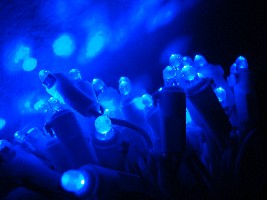Researchers from North Carolina State University in Raleigh have developed a new technique that reduces defects in the gallium nitride (GaN) films used to create light-emitting diodes or LEDs, making this energy-efficient form of lighting even more efficient. The team of engineers and and materials scientists published their findings online in the 17 January issue of the journal Applied Physics Letters.
LED lighting uses thin GaN films to create the diode structure that produces light. The new technique, according to engineering professor Salah Bedair, reduces the number of defects in those films by two to three orders of magnitude, which leads to more light. “For a given input of electrical power, says Bedair, “the output of light can be increased by a factor of two, which is very big.” This is particularly true for low electrical power input and for LEDs emitting in the ultraviolet range.
The researchers started with a GaN film that was two microns, or two millionths of a meter, thick and embedded half of that thickness with large voids -– empty spaces one to two microns long and 0.25 microns in diameter. The researchers found that defects in the film were drawn to the voids and became trapped, leaving the portions of the film above the voids with far fewer defects.
Defects are slight dislocations in the crystalline structure of the GaN films. These dislocations run through the material until they reach the surface. By placing voids in the film, the researchers effectively placed a barrier in the middle of the material, preventing the defects from traveling through the rest of the film.
The voids make a big difference in the number of defects. Without voids, the GaN films have 1010 defects per square centimeter. With voids, the number per square centimeter drops to 107. “This technique would add an extra step to the manufacturing process for LEDs,” notes Bedair, “but it would result in higher quality, more efficient LEDs.”
* * *


 RSS - Posts
RSS - Posts
A doubling in the light output is terrific news for the LED industry and the environment as a whole. Congratulations to the North Carolina State team.
You have to love science. Thanks for the post Alan
My pleasure Bill. Thanks for visiting Science Business.
Valuable information and excellent website you got here! I would like to thank you for sharing your ideas and time into the stuff you post! Thumbs up.
[…] Read more: Researchers Improve Efficiency of LED Lighting […]
[…] Read more: Researchers Improve Efficiency of LED Lighting […]
[…] Read more: Researchers Improve Efficiency of LED Lighting […]